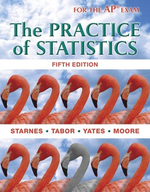Solution Found!
Answer: Section I: Multiple Choice Choose the best answer for Questions AP1.1 to AP1.14
Chapter 4, Problem AP1.5(choose chapter or problem)
Section I: Multiple Choice Choose the best answer for Questions AP1.1 to AP1.14. For a biology project, you measure the weight in grams (g) and the tail length in millimeters (mm) of a group of mice. The equation of the least-squares line for predicting tail length from weight is predicted tail length = 20 + 3 weight Which of the following is not correct? (a) The slope is 3, which indicates that a mouses weight should increase by about 3 grams for each additional millimeter of tail length. (b) The predicted tail length of a mouse that weighs 38 grams is 134 millimeters. (c) By looking at the equation of the least-squares line, you can see that the correlation between weight and tail length is positive. (d) If you had measured the tail length in centimeters instead of millimeters, the slope of the regression line would have been 3/10 = 0.3. (e) One mouse weighed 29 grams and had a tail length of 100 millimeters. The residual for this mouse is 7.
Questions & Answers
QUESTION:
Section I: Multiple Choice Choose the best answer for Questions AP1.1 to AP1.14. For a biology project, you measure the weight in grams (g) and the tail length in millimeters (mm) of a group of mice. The equation of the least-squares line for predicting tail length from weight is predicted tail length = 20 + 3 weight Which of the following is not correct? (a) The slope is 3, which indicates that a mouses weight should increase by about 3 grams for each additional millimeter of tail length. (b) The predicted tail length of a mouse that weighs 38 grams is 134 millimeters. (c) By looking at the equation of the least-squares line, you can see that the correlation between weight and tail length is positive. (d) If you had measured the tail length in centimeters instead of millimeters, the slope of the regression line would have been 3/10 = 0.3. (e) One mouse weighed 29 grams and had a tail length of 100 millimeters. The residual for this mouse is 7.
ANSWER:Step 1 of 5
Given prediction equation:
predicted tail length weight
(a) NOT CORRECT. The slope is the coefficient of weight and thus is 3 . This then also means that the predicted tail length increases by for each additional gram in weight.
